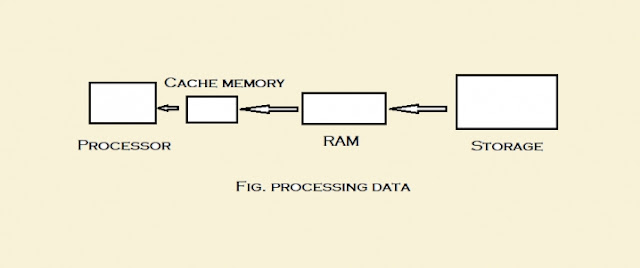Way of Data Process: Processor, Cache Memory, RAM & Storage
We all know that in every main town of every country there must have a bus terminal from where the buses are controlled. The destination is also set from the bus terminal. There are also some counters and by the counters, passengers can trace every bus individually. The motto of buses is to help the passengers to go their destination.
Just think like this. The processor is similar to a bus terminal, Cache memory is similar to bus counter, RAM is similar to the bus, Data is similar to passenger and storage is similar to passenger's home/destination.

According to is it can be said like this way.
I'm Sakib (data). My house (storage) is in Dhaka town. I need to go to Khulna town. If I go to the bus terminal (Processor) and buy a ticket to trace my bus from a counter ( cache memory) then I'll able to go to Khulna town by bus.
In Computer system :
Case 1 :
When I need to create a file, I open the file manager and create a new file and lastly save it in a folder.
Actually, what's happening there?
Analysis: When I give a command to the computer system to create a new file, the processor becomes to know about it and tells the system to create a new file. The file is created in storage. But between these processes, RAM is also doing its job. The file is processing in processor and transferring to the storage via RAM. Cache memory knows where to save the file (destination) and it helps the processor to find out the destination to save it.
Case 2 :
Once my friend wanted to watch a movie. So, he played a movie with the help of a media player. While he was enjoying the movie, his father called him and asked him to go shop to buy some family products. Then he closed the media player and went to the shop. When he came back to the home and again played the movie and it was running from the last scene that he saw last time
Now think why did the movie start from the last moment of sense and why didn't it start from the beginning?
Case 3 :
It was a rainy night. Mr. John was working on an important project on the desktop for 2 hours in his room. His desktop had no extra power supply support likes UPS or IPS. Suddenly the electricity had gone due to natural disaster and when it came, he discovered that all of his works were destroyed.
Analysis of both cases: Here both cases are the example of processing data. In these cases, the stored data first came to the RAM from storage and then to the processor. The processor decided what to do or not to do. In case 2 the data (movie) was shown to monitor and the sound was produced via the sound speaker. These were controlled via the processor. The cache memory stored the last act of watching the movie and then it gave the signal to the processor to start the movie from the last scene.
In the similar thing happens in case 3, data was processed this way storage>RAM>cech memory>processor>user interface. But here the cache memory was unable to store last activity.
Actually, the cache memory remembers the last activities and provides them to the processor if those are needed to access.
Decision & Capability :
Processor: It's the most important part of a computer which controls all processes of a computer system. There may have multiple cores in a processor and noted by Dual-core (2 cores), Quad-core ( 4 cores) [ depending on the number of cores ]. The speed is measuring by GHz. [e.g. 2 GHz ( 2 GB per sec), 3 GHz ( 3 GB per sec ) ].
Cache memory: It helps the processor to remember the last activity. It's the nearest part of the processor. There may have multiple numbers of cache memory in a computer system and noted by this way: L1, L2,..., Ln [ depending on its amount (n=1,2,3,...) ]. It's an expensive memory. The storage is bound in MegaByte (e.g. 1 MB, 3 MB.. depending on CPU's specs). It also has speed capacity ( e.g. 25 MHz ... 5 GHz) and depends on CPU's specs.
RAM: It helps to transfer data for completing processes. The full form of RAM is Random Access Memory and it's volatile memory. It has the storage capacity (e.g. 1 GB, 4 GB) and has bus speed (e.g. 1600 MHz, 2400 MHz).
Storage: It's also called ROM (Read Only Memory).It's nonvolatile memory. It helps to store data for further access. It has Capacity (e.g. 200 GB, 1 TB) and read speed as well as write speed too.
All the imagination things are used for easily understanding the whole process. The bus is used for transportation and it's moveable where RAM is non-moveable computer part. Data is the raw material of information. On the other side, passengers are human. So, it's requested to not make any misunderstanding. Every case is just an example. Nowadays nothing is happening like case 3 due to the optimization of the latest OS.
Source

